As longtime readers of this blog will know, it is my humble opinion that Amazon’s The Wheel Of Time boasts some of the most ambitious and exciting costume design on television: from rainbow-hued Aes Sedai gowns and pantsuits to Aiel desert camouflage, from insect-like Seanchan armor and headdresses to high fantasy bondage gear, every costume is a gamble that pays off in spades. Costume designer Sharon Gilham and her team (pictured below) have played a key role in establishing The Wheel Of Time’s iconic look and feel, and I had the great honor of speaking to her ahead of the series’ third season.
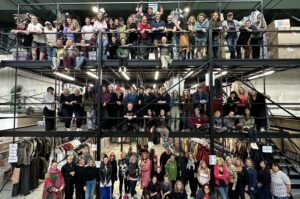
Leith Skilling: What drew you to The Wheel Of Time?
Sharon Gilham: To be honest, I was a bit of a newcomer to the fantasy genre. I hadn’t worked on anything like The Wheel Of Time before, and certainly not on such a huge scale. Not only was it a great challenge in terms of the number of characters and nations to create, but I realized, after my initial meeting with Rafe [Judkins, showrunner] and Marigo [Kehoe, executive producer], that it was going to be an absolutely incredible experience creatively.

LS: Of the costumes you’ve had to try and adapt from page to screen, which has been the most difficult to get to a place where it feels like what the books described but is still practical?
SG: I remember when Rafe first mentioned the Aiel culture to me partway through shooting season two. He described how the Maidens of the Spear — Aviendha, Bain and Chiad — lived a nomadic life and had to carry everything they needed with them, including many weapons. I thought ‘How am I going to make this work dramatically and practically when the spears are 2/3 of the height of the actresses?!’ It was a real challenge but through a process of trial and error and many hours problem solving with the combined skills of Rob Goodwin (couture leather maker), armorers and the props team, we finally created a series of holsters and quick release panels that meant the spears and bucklers could be anchored to the girls’ backs, creating an aesthetically pleasing ‘fan’ shape, and at the same time have a practicality to them.
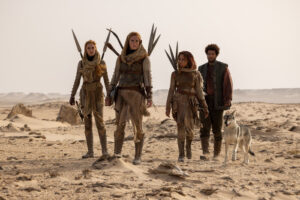
LS: Something I adore about the costumes in The Wheel Of Time is the timeless quality they possess; you can’t lock them down to a specific era, because there’s such a wide range of fabrics and materials on display, as well as techniques. How much freedom do you give yourself in that regard?
SG: The scope of The Wheel Of Time is so huge. Robert Jordan’s detailed descriptions of the cultural references that make up each nation (Cairhien = French/Japanese; Seanchan = Mesoamerican/Imperial Chinese, for example) make for a very rich starting point. The first thing I did was start to collect fabrics, accessories, trims, etc., from the actual cultures described so that we had the authenticity of those fabrics at our fingertips. I shopped in markets in France, in vintage shops in the UK, and suppliers internationally. I tried as much as possible to use all these fabrics directly in the manufacturing of the costumes, which gave them a real sense of being grounded or anchored in reality.
Sometimes it was only a scrap of fabric that was available, so I was lucky enough to be able to enlist the help of our incredibly talented textiles department, who were able to recreate the fabric. This could mean either screen-printing the fabric on our 5m long printing table (the Seanchan culture, the Whitecloaks’ undergarments), hand painting onto silk (Suroth’s kimono, Adeleas’ colorful kimono), or applying foil directly to the fabric (Lanfear’s part-Japanese, part-French coat). One of the cornerstones of the philosophy behind the design process for The Wheel Of Time is that the costumes should feel as if they have been created using pre-Industrial Revolution manufacturing techniques.
The sense of freedom comes from being able to move through different periods of time in our history and find inspiration from those time periods. Everything has a reference and a significance but you can pick and choose your moments and your movements. For example, the Seanchan triangular print which features in all of the costumes of that society from the soldiers to the da’covale to the High Lords and Ladies is based on an Anni Albers design from the 1960s combined with an Alexander McQueen-esque reptilian print. Anything and everything is possible.
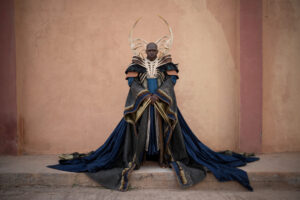
LS: The character of Lanfear has become a fan-favorite in no small part because she’s always so fabulously dressed. My jaw literally dropped when she was revealed in the World of Dreams for the first time at the end of season two, episode five [Damane]. How did you reach that iconic look?
SG: Lanfear — like the other Forsaken — comes from a time when the world was more developed: the time before the ‘Breaking’ when the world collapsed. As such, the Forsaken have the most futuristic style costumes. In the scene you’re describing, Lanfear is at her most devastating, fetishistic, dominatrix self, so it made sense for her costume to reflect this. The design of the bodice is deliberately asymmetrical to show how unbalanced she is, a theme that is often echoed in the Forsaken costumes. I wanted her to have a dramatic headdress which referenced her symbol of the moon and a vicious weapon simultaneously. It also plays with the dual concepts of saidar and saidin, the male and female halves of the One Power, similar to yin and yang. She is at once terrifying and compelling. It is so much fun to incorporate as many of the layers of symbolism in The Wheel Of Time books as possible, even in a single costume.
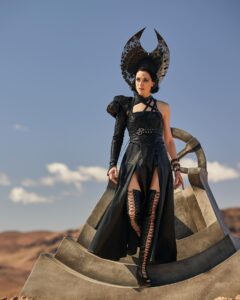
LS: Each of the seven Aes Sedai Ajahs has its own highly individual philosophy. How does that come across in their costumes? And, with a character like Liandrin, how do you convey through clothing that she’s not only Red Ajah but also belongs to the undercover Black Ajah?
SG: When I first started on The Wheel Of Time, I wanted to expand the iconography behind each of the Ajah groups, to give them a kind of rationale relating to color as well as their role within the White Tower. In the books, the Reds are the law enforcement, the Blues spies, the Yellows healers, and so on. I took those colors and those roles and made a series of ‘rules’ about the type of fabrics or shapes of clothing that would be worn to more explicitly demonstrate the connection between the color and the role within the White Tower society and the Wheel Of Time world as a whole.
The Reds have more restrictive clothing and materials — leathers and structured fabrics like wools and heavy cottons — and the Blues have more fluid fabrics that suggest how they flow through the landscape in their search for the truth, and so on. Liandrin’s costumes in season two become gradually more militaristic, almost gestapo-like. In season three, the black even begins to spill into her costume physically. As we move through season three, I wanted her costumes to move away from the physical black into a manifestation that felt even more dangerous, which will become more apparent in later episodes.
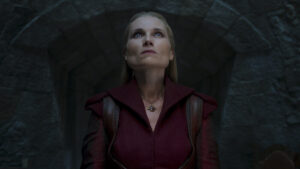
LS: What are you most excited for fans to see in season three?
SG: So many things! There are epic events in almost every episode, there are so many incarnations of so many characters, new worlds and scenarios that unfold and reveal new characters within them…but there is one character that I can’t mention here, that I think fans of the books and Wheel Of Time novices alike will be very excited to see.
LS: On a more personal note, is there any specific film or costume designer’s body of work that inspired you to become a costume designer?
SG: I have been inspired by many films along the way, from Peter Greenaway films like The Cook, The Thief, His Wife & Her Lover, Chen Kaige’s Farewell My Concubine, Wong Kar-wai’s In The Mood For Love, Baz Luhrmann’s Romeo + Juliet, Eiko Ishioka’s costumes for The Fall, Linda Muir’s work on films like Nosferatu, and Michele Clapton’s work on Game Of Thrones, which really pushed fantasy into a new era. You can see where the costume designer has been allowed a kind of freedom, which results in a really strong visual aesthetic to the work. This was the case for me on The Wheel Of Time.
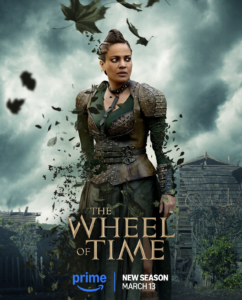
LS: And finally, of the seven Aes Sedai Ajahs, which would you belong to and why?
SG: Well, it has to be the Greens. Partly because these days more than ever women need to embrace and manifest the warrior inside; and partly because I was given a green Aes Sedai ring as a birthday present from my team and it was personally presented to me by none other than Moiraine Damodred herself!
The Wheel Of Time returns for its third season on March 13th, only on Prime Video.
















